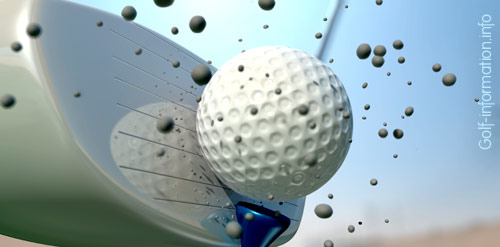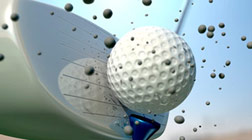(and other shaft properties such as flex point)

Shaft properties such as shaft flex, shaft torque, flex point (kick or bend point), shaft length and weight, influence playability by impacting on trajectory, accuracy, balance, consistency and feel. This is particularly true for graphite shafts as some variables are only of importance in graphite shafts.
1. Definition of Shaft Flex
Shaft flex has a very pronounced effect on the power and accuracy of a driver. The flex of a shaft allows it to store energy from a player’s downswing, and release it as the head makes contact for increased club speed at impact. This “whip” action imparts greater impulse on the ball for maximum distance, which is essential to a good wood shot. This requires a fine balance; a shaft that is too stiff cannot be flexed by the golfer during their downswing, which reduces club speed at impact. A shaft that is too flexible will retain some of its stored flex at contact, wasting energy and changing the angle between club face and ball at impact, causing inconsistent shots. The strength of a golfer’s swing, and therefore the required flex for maximum impact speed, changes over time and can be different from day to day, complicating this equation; the best answer is a shaft that is the best fit for the player’s average swing power, or else a shaft that matches the player’s maximum club speed, so the player retains accuracy on his/her most powerful shots.
2. How Shaft Flex can influence your game

by Tom Wishon
More info >>
Shafts come in a variety of flexes. The most common are: L (Lady), A (Soft Regular, Intermediate or Senior), R (Regular), S (Stiff), and X (Tour Stiff, Extra Stiff or Strong).
A regular flex shaft (R) is generally appropriate for those with an average head speed (80-94 mph), while an A-Flex (or intermediate shaft) is for players with a slower swing speed (70-79 mph).
The stiffer shafts, such as S-Flex and X-Flex (Stiff and Extra-Stiff shafts) are reserved only for those players with an above average swinging speed, usually above 100 mph (160 km/h).
Some companies also offer a “stiff-regular” or “firm” flex for players whose club speed falls in the upper range of a Regular shaft (90-100 mph), allowing golfers and clubmakers to fine-tune the flex for a stronger amateur-level player.
As a general rule one can say that at a giving swing speed a stiffer shaft will produce a lower flight, shorter distance and increased accuracy, while a more flexible shaft will produce a higher shot, but more left/right variance and a little more distance. Players with accuracy problems or whose swing tends to go to the left (for-right-handed golfers) should usually move toward stiffer shafts. Golfers whose swing tends to go to the right (for right-handed golfers) may benefit from a softer flex which will allow them to square the clubface more easily.
However, more than often directional control problems are caused by the grip or golfer’s tempo, not by the shaft type. For the shaft to have any effect on the tempo and flight, the golfer’s hands must work as one unit with a late wrist-cock angle release. The earlier the golfer releases the club on the downswing, the less the shaft’s proprieties will have an impact and height and spin. Golfers with an early release tend to hit the ball the same height with any shaft they use.
Note that while the shaft cannot increase the power delivered by the golfer to the ball an ill-fit shaft can decrease that power.
For more info see: How the choose the correct shaft flex for your game.
High handicappers might want to read this article first: How to choose the Best Golf Clubs for your Game.
3. Shaft Torque

by John Zumerchik
More info>>
Shaft torque is another critical component. Flex and torque are generally related; the more a club can flex, the more it can also twist around its axis (though this is not always the case).
The torque is expressed in degrees. The torque of steel shafts does not vary much and is situated around 3 degrees, while graphite shafts can range from 1 degree to 7 or 8 degrees. A high torque number means that the shaft can torque easily and is less forgiving of off-center shots as it will allow the head to twist, causing pulls and pushes.
Low-torque shafts resist twisting for more forgiving behavior, but tend to be stiffer and require more power for proper distance. The higher toque number clubs will also feel softer, while the low torque numbers will feel firmer.
The difference in shaft torque will usually not be noticeable to the average golfer. The latest generation of driver shafts combine a flexible shaft with a stiff tip, giving the golfer the required flex to “whip” into the ball while reducing clubhead twisting.
4. Kick point or Flex point
The kick-point (flex-point or bend-point) refers to a maximum bending point of the shaft. A high flex point or kick point means the club will bend closer to the grip. A low flex point or kick point refers to a flex point closer to the clubhead. A lower kick-point means that the club-head moves more through impact, while a high kick-point shaft is much easer to control direction. Since more golf clubs are made with low center of gravity club-heads, low kick-point shafts seem to have lost some of their importance.
If all this seems much too detailed and overwhelming, read this article: How to choose the Best Golf Clubs for your Game.
Further Reading:
Newton on the Tee by John Zumerchik. New York: Simon & Schuster 2002.
See also:
Types of Golf Clubs
Tips to choose your Golf Shoes
How to choose the best Golf Clubs for your Game
Choosing the right golf shaft flex

